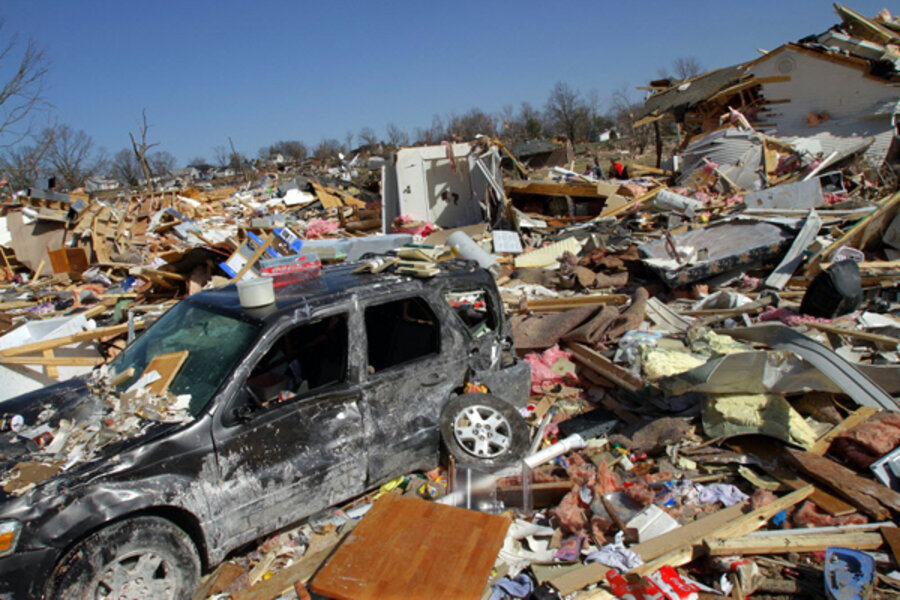Storm-ravaged communities brace for more violent weather
Loading...
| HARRISBURG, Ill.
Crews cleared splintered plywood and smashed appliances from small-town neighborhoods Thursday, a day after tornadoes killed 13 people in the Midwest and South. But the forecast held a menacing possibility: More twisters may be coming, and they could be even stronger.
Damaged communities tried to take advantage of the brief break in the weather, mindful of one meteorologist's warning that by Friday, both regions would again be "right in the bull's eye."
Skies were sunny in the southern Illinois community of Harrisburg, where Darrell Osman was back in the rubble of his dead mother's home, trying to salvage whatever he could. When he arrived, a neighbor handed him his mother's wallet, which the storm had deposited in a truck near her home.
He couldn't help but think of the pain that would be inflicted if another twister hit Harrisburg, where six people were killed.
"On a personal level, I think I've been hit as hard as I can be hit, but it would be disheartening for this community," Osman said.
National Weather Service meteorologist Beverly Poole said severe storms are expected to roll through the region again after midnight Thursday and linger into early Friday, possibly bringing hail and rain.
Then yet another system is expected to arrive Friday afternoon.
Both rounds of violent weather carry the potential of more tornadoes, Poole said.
The weather service planned to bring a severe-weather specialist to the region's command center to provide up-to-the-minute information before and during the storms.
Osman awoke before Wednesday's storm because he was alerted by his special weather radio. He said early warning equipment was essential.
"The peace of mind you get from it sitting on your dresser is well worth the cost," he said.
Authorities warned that the next line of storms was forecast to take a similar path and potentially grow stronger than Wednesday's system.
Ryan Jewell, a meteorologist with the Storm Prediction Center, said, both the Midwest and South will be directly in the danger zone.
In Missouri, one person was killed in the town of Buffalo, while two more fatalities were reported in the Cassville and Puxico areas. All three died in mobile homes.
A Harveyville, Kan., man suffered fatal injuries after his home collapsed on him.
Another twister hopscotched down the main thoroughfare of the country music mecca of Branson, Mo., damaging some of the city's famous theaters just days before the start of the town's crucial tourist season.
Local leaders insisted Branson was open for business, but they expected the full cleanup to take weeks.
The Harrisburg tornado was an EF4, the second-highest rating given to twisters based on damage. Scientists said it was 200 yards wide with winds up to 170 mph.
Adding to the danger was the storm's timing: It hit when many people were fast slept.
Meteorologist Harold Brooks called that unusual but "not completely uncommon."
Brooks, with the National Severe Storms Laboratory in Norman, Okla., said perhaps 10 percent of tornadoesstrike between midnight and 6 a.m., a time when storms are harder to spot, and it's harder to get the word out.
"If you're asleep, you're less likely going to hear anything, any warning message on the danger," Brooks said.
That didn't appear to be the case in Harrisburg, where the mayor credited storm spotters for saving lives.
In eastern Tennessee, where three people were killed, donated storage units were to be offered to families whose homes were damaged so they could store possessions before the next line of storms.
The brother-in-law of a Tennessee woman who was killed said he found her under some debris and held her hand until paramedics arrived.
George Jones and several relatives gathered Thursday at the shattered home of Melissa Evans Beaty outside the small city of Crossville, about 110 miles east of Nashville.
He said Beaty, whom they called Lisa, was alive and asking about her children when he found her.
The children were all right, but Beaty's husband, Ricky, was taken to a Knoxville hospital with a fractured pelvis and severe head trauma, Jones said.
"We would give anything, to have Lisa back," he added.
The couple's home was completely destroyed, with pieces wrapped around nearby trees.
Bunny Howe survived the storm with her 9-year-old grandsons by climbing into a bathtub as she watched the wind pick up one of her horses in the back yard, then overturn part of a tractor-trailer in the front yard.
That's when she got on top of the children and held the bathroom door shut with her feet.
The children asked her, "Ma, what are we going to do?'" She told them, "We're going to pray."
The tornado tore off a wall of the Howes' garage and toppled a tree onto the roof.
After all that, Howe said, she's not overly concerned about storms predicted for Friday.
"What's it going to do?" she asked. "Take the rest of the house down?"







